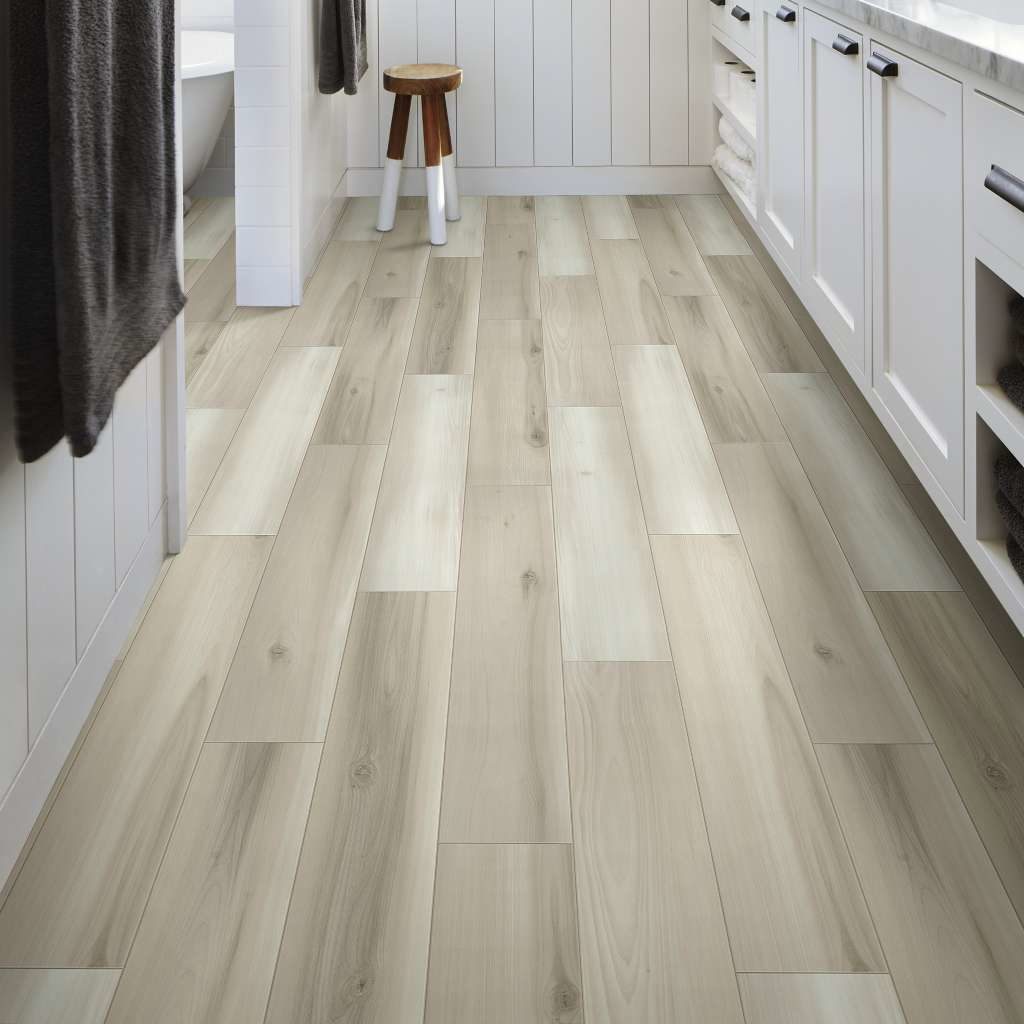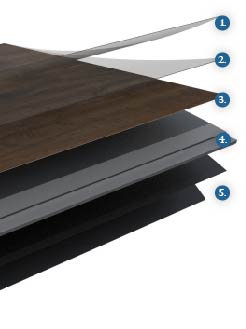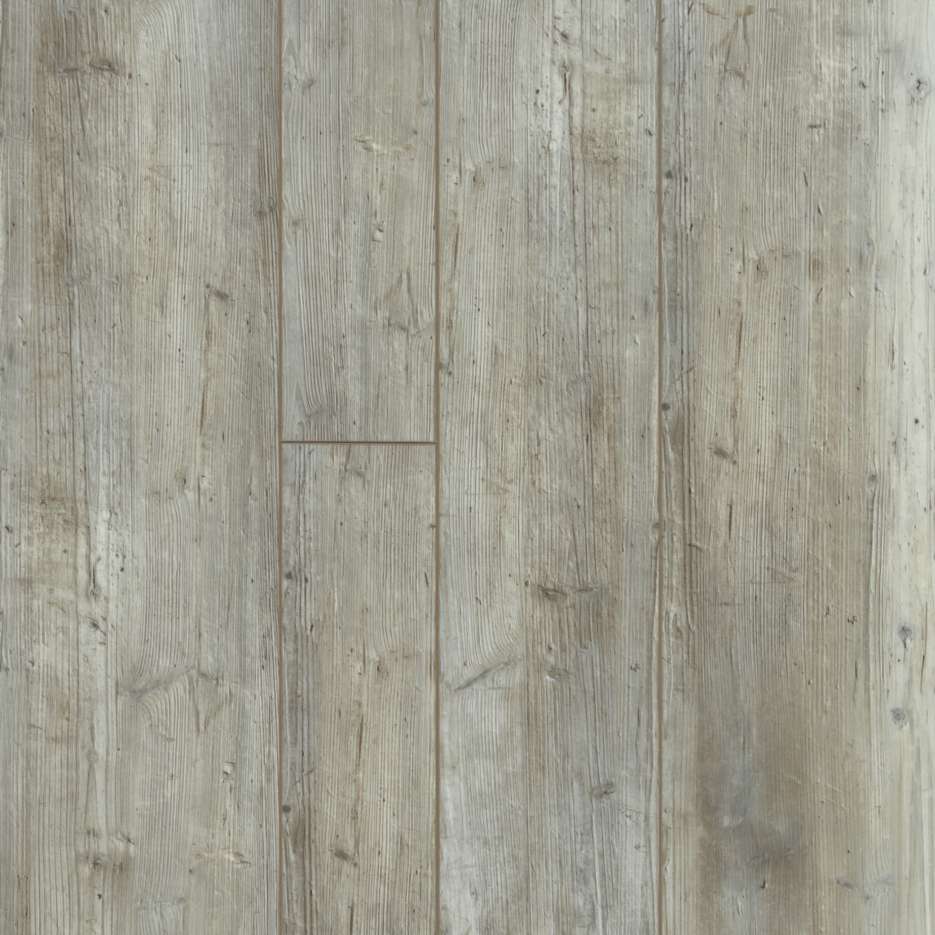Vinyl Plank Flooring has been around for a few years now and we don’t see it leaving anytime soon. A versatile and attractive flooring option, vinyl plank is a far superior product then it’s ancestor – sheet vinyl.
So what makes vinyl plank so good? Read on to discover the differences between vinyl products, what specifications mean what, and why you should choose this product for your home.
Types of Vinyl Floors
Before we get into the specifics on vinyl planks, it’s important that you understand the different types of vinyl flooring overall, and how they differ from each other.

Luxury Vinyl Plank
LVP is a luxury vinyl flooring that mimics the look of real wood planks in everything from color to wood species. The plank sizes can also vary in width and length, and can in some cases be installed in different patterns giving you a real wood floor look at half the price (and problems!)

Luxury Vinyl Tile
LVT refers to luxury vinyl products that look like stone or ceramic tile. They can mimic the look, color and different size variations of ceramic tile but are typically warmer underfoot than a tile would be.

Sheet Vinyl
When most people think about sheet vinyl flooring, they think 1970’s beige “tile” flooring. But sheet vinyl flooring has really come a long way in looks since then. Sheet Vinyl is glued directly to the subfloor, and, unlike LVP, there is typically no texture or dimension added to it.
Vinyl Floor Materials

Vinyl Flooring is essentially made up of layers, much like the earth. If you cut a piece of vinyl in half you would see the different materials used to create it. Below we will explain what the purpose of each layer is, and the good & bad materials that are used.
5. The Underlay
The first layer is the underlay. Most vinyl plank and tiles on the market today have some sort of underlayment attached to each plank, or tile. The type and features of underlay can differ by manufacturer, but the overall purpose of an underlay is to add comfort underfoot and noise reduction.
Some manufacturers will also add a layer of antibacterial protection to the underlay. Torlys flooring, for example, adds Microban technology as explained below:
“Microban® technology is built-in antimicrobial protection that gives products an added level of protection against the growth of bacteria, mold and mildew on household products, keeping your home cleaner and reducing odors.”
4. The Core
When you research what vinyl plank is made of, you have undoubtedly come across 2 words – WPC and SPC. Those are the 2 materials that make up the core of vinyl flooring. But what do they mean?
WPC Core
Wood Plastic Composite is a composition of wood and plastic materials pressed together to make a solid core. It is very durable, water resistant and typically it is softer than SPC.
WPC is less dense than SPC therefore it will retain more warmth and it is slightly more expensive than a floor with an SPC core in it.
SPC Core
Stone Plastic Composite is a composition of stone and plastic materials pressed together to make a solid core. It is very durable, water resistant and is more dense and rigid, meaning it will get colder than a WPC core would.
It is also typically less expensive than WPC.
3. The Print
Above the core rest the luxury print, or in essence the high definition “picture” of the flooring. As mentioned above, luxury vinyl flooring can be produced in almost any color, species and style. So getting a flooring that looks like real wood is no problem. In fact, most vinyl plank floorings these days are so realistic it’s almost impossible to tell them apart from hardwood.
2. The Wear Layer
The top, and usually the last, layer is the wear layer. It is usually a clear, urethane based coating to protect the other layers, and prevents against wear of the flooring.
The wear layer can come in varying thicknesses, typically between 6 – 22 mils thick. The thicker the wear layer, the tougher the flooring will be. Most 20 mil thicken wear layers are commercially rated, meaning they can stand up to high traffic areas, such as foyers or mud rooms.
1. Bonus! Top Coat
Why Choose Vinyl Flooring?

There are numerous benefits to selecting a vinyl plank or tile flooring for your home. Each manufacturer will have some different additions to their flooring, good or bad, but generally speaking a vinyl flooring product is an all around good choice. Here are the top 5 reasons we think a vinyl plank is a good option.
- You can install vinyl flooring in pretty much any room in your home. Because vinyl flooring is water resistant, you can have that wood look in rooms you wouldn’t be able to with an actual wood floor such as bathrooms or laundry rooms.
- Don’t just think floors either. Vinyl products can be installed on a wall or ceiling for a statement feature in any room. Our designers like to add vinyl planks to fireplace boxouts and walls too.
- It is durable. If you have pets and/or children, then vinyl plank is the way to go. Because of the material used to make vinyl flooring, it is significantly harder to dent or chip. And when you spill a glass of wine on it, you only have to cry over the wasted wine and not the ruined floor too. Just wipe clean, and carry on!
- If you do happen to wreck a piece of vinyl flooring, simply pop it out and replace it with another piece. It’s very easy to fix, and won’t cost you a fortune either. In most cases you can do it yourself!
- It can be installed over any surface, without requiring a sub floor. If you are re doing your basement for example, you don’t need to add anything between the concrete floor and the vinyl. Simply click the pieces together, and presto! Man cave done.



We hope this blog has helped you learn a little bit more about vinyl plank and tile flooring.
For even more information about vinyl plank flooring I encourage you to check out SHAW floorings YouTube channel. It has a ton of useful information and demonstrations for all flooring types.
To search the vinyl plank products that we offer at designQ click here!




